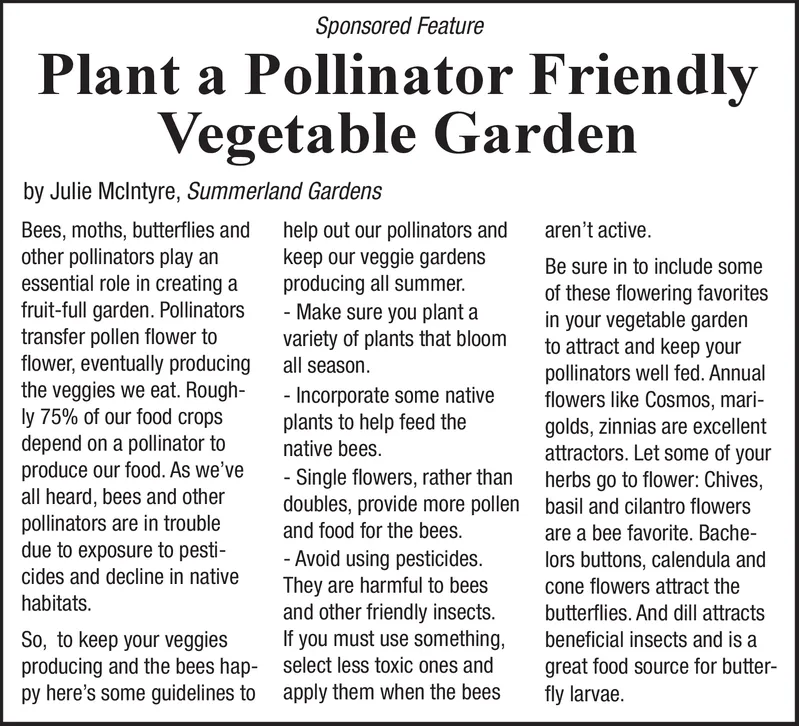Advertisement

-
Published Date
May 18, 2019This ad was originally published on this date and may contain an offer that is no longer valid. To learn more about this business and its most recent offers, click here.
Ad Text
Sponsored Feature Plant a Pollinator Friendlv Vegetable Garden by Julie Mclntyre, Summerland Gardens Bees, moths, butterflies and help out our pollinators and other pollinators play an essential role in creating a producing all summer. fruit-full garden. Pollinators Make sure you plant a transfer pollen flower to flower, eventually producing all season aren't active keep our veggie gardens Be sure in to include some of these flowering favorites in your vegetable garden to attract and keep your pollinators well fed. Annual lowers like Cosmos, mari- variety of plants that bloom e eat. Rough- s Incorporate some native plants to help feed the native bees. ly 75% of our food crops depend on a pollinator to produce our food. As we've all heard, bees and other pollinators are in trouble due to exposure to pesti- cides and decline in native golds, zinnias are excellent attractors. Let some of your herbs go to flower: Chives, Single flowers, rather than doubles, provide more pollen and food for the bees basil and cilantro flowers are a bee favorite. Bache- -Avoid using pesticide:s They are harmful to bees and other friendly insects If you must use something, select less toxic ones and lors buttons, calendula and cone flowers attract the habitats butterflies. And dill attracts So, to keep your veggies producing and the bees hap- py here's some guidelines to beneficial insects and is a great food source for butter- fly larvae apply them when the bees Sponsored Feature Plant a Pollinator Friendlv Vegetable Garden by Julie Mclntyre, Summerland Gardens Bees, moths, butterflies and help out our pollinators and other pollinators play an essential role in creating a producing all summer. fruit-full garden. Pollinators Make sure you plant a transfer pollen flower to flower, eventually producing all season aren't active keep our veggie gardens Be sure in to include some of these flowering favorites in your vegetable garden to attract and keep your pollinators well fed. Annual lowers like Cosmos, mari- variety of plants that bloom e eat. Rough- s Incorporate some native plants to help feed the native bees. ly 75 % of our food crops depend on a pollinator to produce our food. As we've all heard, bees and other pollinators are in trouble due to exposure to pesti- cides and decline in native golds, zinnias are excellent attractors. Let some of your herbs go to flower: Chives, Single flowers, rather than doubles, provide more pollen and food for the bees basil and cilantro flowers are a bee favorite. Bache- -Avoid using pesticide:s They are harmful to bees and other friendly insects If you must use something, select less toxic ones and lors buttons, calendula and cone flowers attract the habitats butterflies. And dill attracts So, to keep your veggies producing and the bees hap- py here's some guidelines to beneficial insects and is a great food source for butter- fly larvae apply them when the bees
